unit3B2说课稿
- 格式:doc
- 大小:30.00 KB
- 文档页数:5
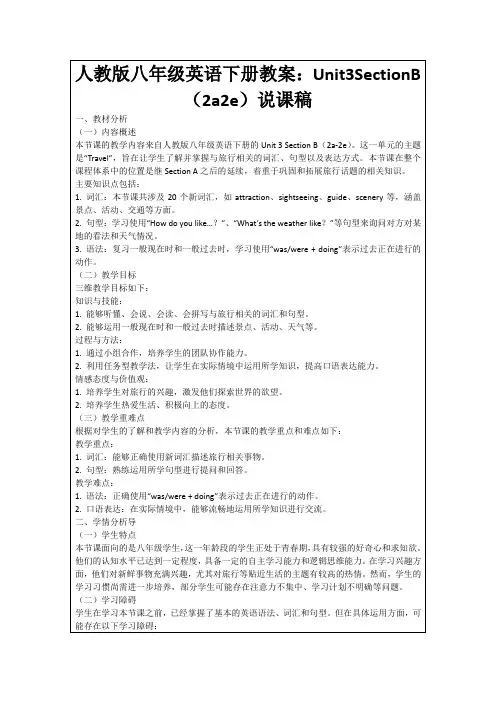
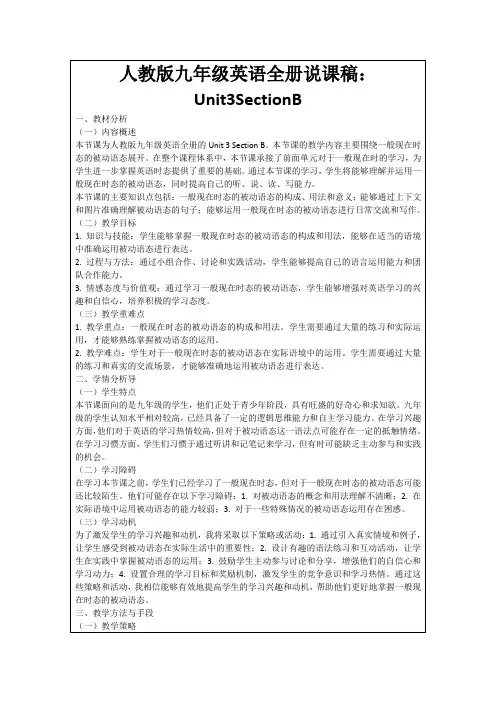

仁爱英语八年级(上)说课稿Unit 3 Our HobbiesTopic 2 What Sweet MusicSecti on B一.说教材1. 教材地位和作用本节课的教学材料是八年级(初二)上册第三单元Topic 2的第2课,单元的主题是:我们的爱好;Topic2的主题是:美妙的音乐。
在Topic 1的话题中,学生已经学习了不同的兴趣爱好;学会了如何表达自己“对某事/人感兴趣”、“喜欢做某事”等;并且学会了如何和他人谈论自己的业余兴趣爱好。
通过兴趣爱好的培养,陶冶自己的性情,提高自己的个人修养。
本单元(Topic 2)的教学活动继续围绕谈论个人兴趣和爱好以及了解音乐知识而展开的。
本节课是Topic2的第二课,承接第一课的乐器,这一课着重介绍音乐的类型,并通过听说读写等活动让学生谈论对不同音乐的感受,掌握关于“喜欢和不喜欢的功能表达。
通过谈论音乐,学生们了解了音乐的类型和特点,了解了中西方的音乐文化,陶冶了性情,以更加乐观、积极的态度投入到自己的学习和生活。
根据教材内容,本节课是一堂以听说为主的英语操练课。
2. 教学目标(1)语言知识目标a. 学习并操练新的单词和词组:everyday, simple, be famous for, folk songb. 学习并运用相关的句子谈论不同音乐类型的特点,如:Classical music is serious music./Pop music ofte n comes and goes quickly./Cou ntry music, rock music and jazz are all pop music./Folk music is simple but special.c. 运用句型来谈论对不同音乐的不同感受,掌握“喜欢和不喜欢”的表达。
如: It ' s great! I love/I t!is good music./I don ' t like this kind of mus池hate to listen to rock music./It ' s not my/orite, but I don ' t mind it.d. 学习和运用感叹句的表达,如:It ' gseat! I love it!/ How exciting!/What sweet music!(2)语言技能目标:在听、说、读、写活动中,训练学生的获取信息能力、逻辑思维能力、反应能力和实践能力,使学生能熟练应用所要求掌握的语言知识来参与讨论音乐的话题。
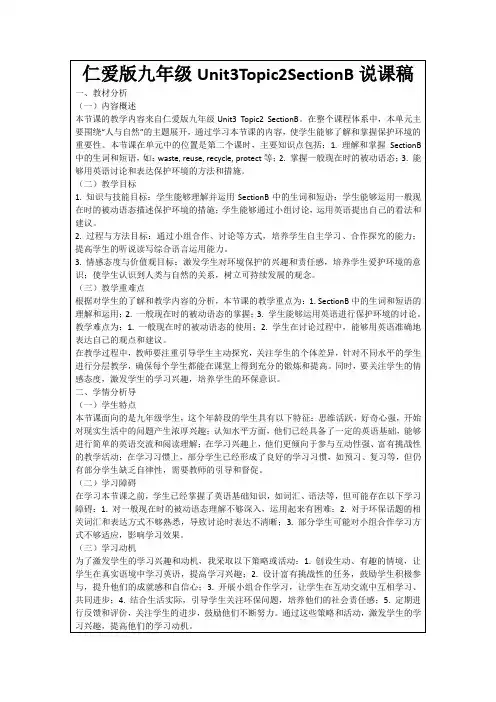
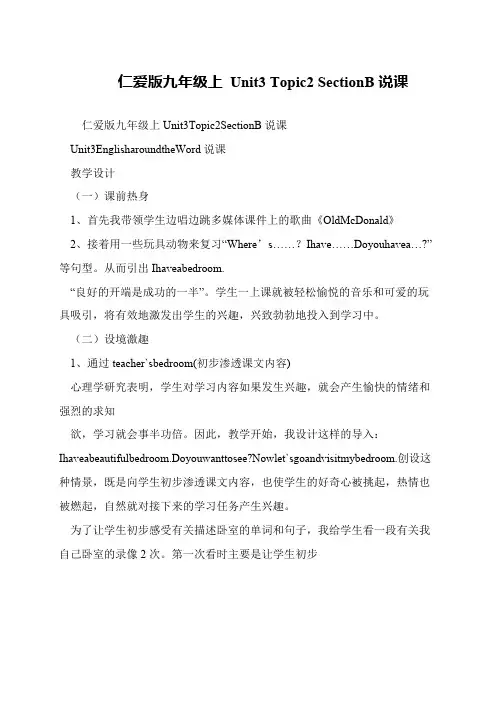
仁爱版九年级上Unit3 Topic2 SectionB说课
仁爱版九年级上Unit3Topic2SectionB说课
Unit3EnglisharoundtheWord说课
教学设计
(一)课前热身
1、首先我带领学生边唱边跳多媒体课件上的歌曲《OldMcDonald》
2、接着用一些玩具动物来复习“Where’s……?Ihave……Doyouhavea…?”等句型。
从而引出Ihaveabedroom.
“良好的开端是成功的一半”。
学生一上课就被轻松愉悦的音乐和可爱的玩具吸引,将有效地激发出学生的兴趣,兴致勃勃地投入到学习中。
(二)设境激趣
1、通过teacher`sbedroom(初步渗透课文内容)
心理学研究表明,学生对学习内容如果发生兴趣,就会产生愉快的情绪和强烈的求知
欲,学习就会事半功倍。
因此,教学开始,我设计这样的导入:Ihaveabeautifulbedroom.Doyouwanttosee?Nowlet`sgoandvisitmybedroom.创设这种情景,既是向学生初步渗透课文内容,也使学生的好奇心被挑起,热情也被燃起,自然就对接下来的学习任务产生兴趣。
为了让学生初步感受有关描述卧室的单词和句子,我给学生看一段有关我自己卧室的录像2次。
第一次看时主要是让学生初步。
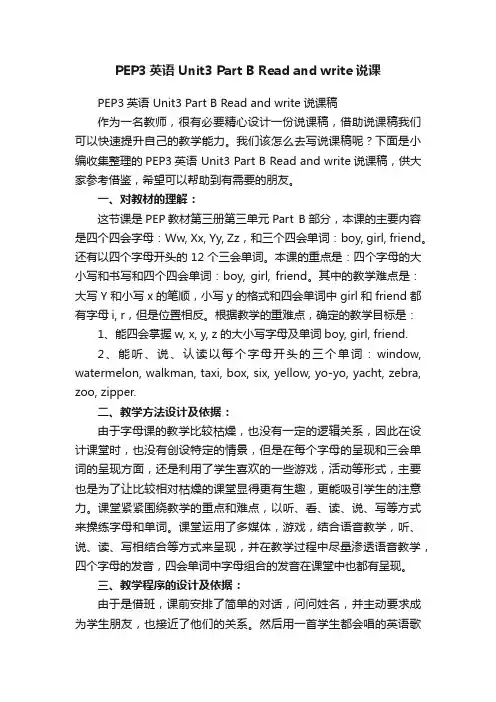
PEP3英语 Unit3 Part B Read and write说课PEP3英语 Unit3 Part B Read and write说课稿作为一名教师,很有必要精心设计一份说课稿,借助说课稿我们可以快速提升自己的教学能力。
我们该怎么去写说课稿呢?下面是小编收集整理的PEP3英语 Unit3 Part B Read and write说课稿,供大家参考借鉴,希望可以帮助到有需要的朋友。
一、对教材的理解:这节课是PEP教材第三册第三单元Part B部分,本课的主要内容是四个四会字母:Ww, Xx, Yy, Zz,和三个四会单词:boy, girl, friend。
还有以四个字母开头的12个三会单词。
本课的重点是:四个字母的大小写和书写和四个四会单词:boy, girl, friend。
其中的教学难点是:大写Y和小写x的笔顺,小写y的格式和四会单词中girl和friend都有字母i, r,但是位置相反。
根据教学的重难点,确定的教学目标是:1、能四会掌握w, x, y, z的大小写字母及单词boy, girl, friend.2、能听、说、认读以每个字母开头的三个单词:window, watermelon, walkman, taxi, box, six, yellow, yo-yo, yacht, zebra, zoo, zipper.二、教学方法设计及依据:由于字母课的教学比较枯燥,也没有一定的逻辑关系,因此在设计课堂时,也没有创设特定的情景,但是在每个字母的呈现和三会单词的呈现方面,还是利用了学生喜欢的一些游戏,活动等形式,主要也是为了让比较相对枯燥的课堂显得更有生趣,更能吸引学生的注意力。
课堂紧紧围绕教学的重点和难点,以听、看、读、说、写等方式来操练字母和单词。
课堂运用了多媒体,游戏,结合语音教学,听、说、读、写相结合等方式来呈现,并在教学过程中尽量渗透语音教学,四个字母的发音,四会单词中字母组合的发音在课堂中也都有呈现。
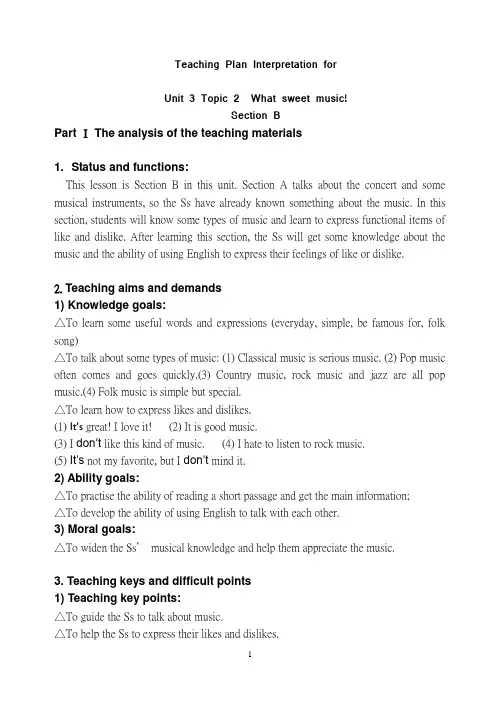
Teaching Plan Interpretation forUnit 3 Topic 2 What sweet music!Section BPart Ⅰ The analysis of the teaching materials1. Status and functions:This lesson is Section B in this unit. Section A talks about the concert and some musical instruments, so the Ss have already known something about the music. In this section, students will know some types of music and learn to express functional items of like and dislike. After learning this section, the Ss will get some knowledge about the music and the ability of using English to express their feelings of like or dislike.2. Teaching aims and demands1) Knowledge goals:△To learn some useful words and expressions (everyday, simple, be famous for, folk song)△To talk about some types of music: (1) Classical music is serious music. (2) Pop music often comes and goes quickly.(3) Country music, rock music and jazz are all pop music.(4) Folk music is simple but special.△To learn how to express likes and dislikes.(1) It’s great! I love it! (2) It is good music.(3) I don’t like this kind of music. (4) I hate to listen to rock music.(5) It’s not my favorite, but I don’t mind it.2) Ability goals:△To practise the ability of reading a short passage and get the main information;△To develop the ability of using English to talk with each other.3) Moral goals:△To widen the Ss’ musical knowledge and help them appreciate the music.3. Teaching keys and difficult points1) Teaching key points:△To guide the Ss to talk about music.△To help the Ss to express their likes and dislike s.2) Teaching difficult points:△How to make the Ss’take an active in talking about the music ;△How to organise the Ss’to do some listening.Part Ⅱ The analysis of the teaching methods and teaching aids1) Teaching methods:△Using inspiration to make the Ss learn the knowledge step by step;△Using audiovisual teaching method to attract the Ss’attenti on and arouse the Ss’interest;△Using situtation teaching method to creat several situations to make the Ss learn English easily and use it freely.2) Teaching aids:In this section, I will apply the multimedia to make the input visible, interesting, comprehensible and thus to make the Ss become interested in the class.Part Ⅲ The analysis of my studentsThe Ss have learned English for more than one year, so they have the basic English knowledge and the ability of listening and speaking. What is more, psychologically, the junior students are teenagers who are curious, active and fond of games, competitions, songs and various activities. They enjoy learning in the exciting, interesting and relaxed atmosphere. They are challenged to take an active part in varied kinds of activities. Therefore, group competition and cooperation could help them learn to cooperate with each other and have fun in learning English at the same time. Besides, discussion can greatly arouse the students in this topic.According to the analysis of my students, I will adopt the task-based approach and design a few activities to help them understand this lesson.Part Ⅳ The analysis of the teaching procedureStep 1 Warming up (5’)1.Listen to the music and talk about the music .(Aims: To arouse the Ss’interest in learning English and creat a cheerful atmosphere.) ( Choose the music of the singer, Jay Chou ,who is one of the most popular singersamong young people. Ask the Ss to sing together. After listening , talk about the music with the Ss.)Ask and answer:--T: Who’s the singer? --Ss: Jay Chou.(周杰伦)--T: What’s the name of the song? -- Ss: It’s《菊花台》.--T: What kind of music is it? --Ss: It’s Pop music.--T: How many kinds of music are there? Do you know? --Ss: Sorry,I don’t know.--T: Now, let me tell you. There are folk music, pop music, rock music, country music and so on.Step 2 Presentation (8’)1.Listen to 1a and answer the two questions.(1)What does Wen Wei do in his free time?(2)Does Wen Wei like classical music?(Check the answers: 1.He listens to the music. 2.No, he doesn’t like it at all.)2.Listen to 1a again, and find out the answers to the following questions.(3)What kind of music did Wen Wei use to enjoy?(4)What kind of music does he like now?(5)What kind of music does Jane like best?(Check the answers: 3. He used to enjoy pop music. 4.He likes folk music now.5. She likes pop music best.)(Aims: To train the Ss’ listening abilities.)Step 3 Consolidation (15’)1.Ask the Ss to listen to 1a and read after it. Pay attention to the intonation.2.Role-playing: Boys read after Wen Wei and girls read after Jane.3.Act out the dialogue in 1a in pairs. Ask some Ss to act it out.4.Work alone. Read and fill in the blanks in 1b according to 1a. Check the answers. (Aims:To master some expressions which are useful for speaking and writing)5.Pair workUsing the following sentences, make conversations similar to 1a to describe your feelings about different kinds of music.(Aims: To develop the Ss’ cooperation)Step 4 Practice (12’)1. Listen to 2 twice, choose the right answers. Then check the answers.2. Read and understand. Ask the Ss to read 3a by themselves and then answer the following questions.(1)How many kinds of music do you learn from the passage? What are they?(2)Who wrote great classical music?(3)What are pop music?(4)Who are famous for their folk songs?Answers:(1)Three. They are classical music, pop music and folk music.(2)Beethoven and Mozart.(3)Country music, rock music and jazz are all pop music.(4)Guo Lanying, Song Zuying and Tenger are famous for folk songs.(Aims: To develop the ability of reading)3. Listen to some kinds of music and finish the exercises.Listen to the first kind of music and identify what kind of music it is. Then fill in the4. Ask the Ss to read after .5.Explain some key points in 3a.Step 5 Project (5’)1.Make a survey. Ask the Ss to make a survey in the class. Using the following sentences:A:--Who is your favorite singer? B:--My favorite singer is…A:--What is your favorite song? B:--My favorite song is…A:--Why? B:--Because it is s weet/great/wonderful …(Aims: T o develop the Ss’ competition and cooperation, make sure that everyone joins in the activities to practise their speaking and writing abilities.)2.Homework:(1)Write a short passage about“Which kind of music do you like? Why?”(2)Finish the Workbook(Section B).3.Listen and enjoy a song.Part V Blackboard writing layout:△Here is a form bout the competition. It’s on the right of the blackboard.。
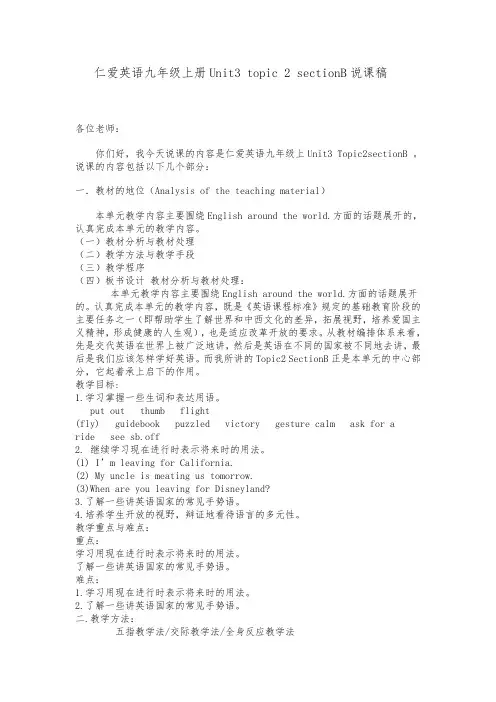
仁爱英语九年级上册Unit3 topic 2 sectionB说课稿各位老师:你们好,我今天说课的内容是仁爱英语九年级上Unit3 Topic2sectionB 。
说课的内容包括以下几个部分:一.教材的地位(Analysis of the teaching material)本单元教学内容主要围绕English around the world.方面的话题展开的,认真完成本单元的教学内容。
(一)教材分析与教材处理(二)教学方法与教学手段(三)教学程序(四)板书设计教材分析与教材处理:本单元教学内容主要围绕English around the world.方面的话题展开的。
认真完成本单元的教学内容,既是《英语课程标准》规定的基础教育阶段的主要任务之一(即帮助学生了解世界和中西文化的差异,拓展视野,培养爱国主义精神,形成健康的人生观),也是适应改革开放的要求。
从教材编排体系来看,先是交代英语在世界上被广泛地讲,然后是英语在不同的国家被不同地去讲,最后是我们应该怎样学好英语。
而我所讲的Topic2 SectionB正是本单元的中心部分,它起着承上启下的作用。
教学目标:1.学习掌握一些生词和表达用语。
put out thumb flight(fly) guidebook puzzled victory gesture calm ask for aride see sb.off2. 继续学习现在进行时表示将来时的用法。
(1) I’m leaving for California.(2) My uncle is meating us tomorrow.(3)When are you leaving for Disneyland?3.了解一些讲英语国家的常见手势语。
4.培养学生开放的视野,辩证地看待语言的多元性。
教学重点与难点:重点:学习用现在进行时表示将来时的用法。
了解一些讲英语国家的常见手势语。
难点:1.学习用现在进行时表示将来时的用法。
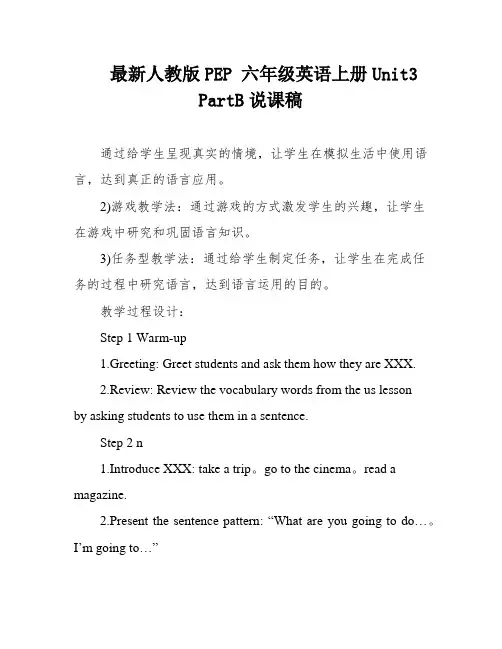
最新人教版PEP 六年级英语上册Unit3PartB说课稿通过给学生呈现真实的情境,让学生在模拟生活中使用语言,达到真正的语言应用。
2)游戏教学法:通过游戏的方式激发学生的兴趣,让学生在游戏中研究和巩固语言知识。
3)任务型教学法:通过给学生制定任务,让学生在完成任务的过程中研究语言,达到语言运用的目的。
教学过程设计:Step 1 Warm-up1.Greeting: Greet students and ask them how they are XXX.2.Review: Review the vocabulary words from the us lessonby asking students to use them in a sentence.Step 2 n1.Introduce XXX: take a trip。
go to the cinema。
read a magazine.2.Present the sentence pattern: “What are you going to do…。
I’m going to…”3.Introduce the time phrases: next week。
this XXX。
tomorrow。
tonight.Step 3 Practice1.Play a game: “What’s in the bag?” Put different items related to the vocabulary words in a bag and have students take XXX’s inside.2.Pair work: Students work in pairs and ask each other what they are going to do using the XXX.3.Group work: Divide students into groups and have them plan a trip using the new XXX pattern。

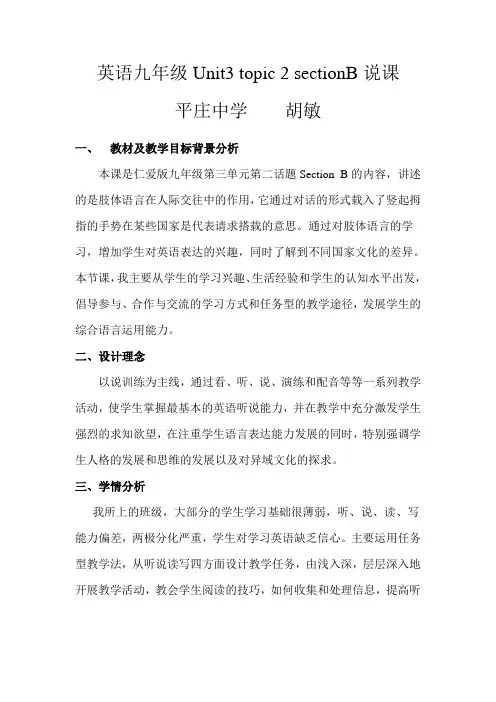
英语九年级Unit3 topic 2 sectionB说课平庄中学胡敏一、教材及教学目标背景分析本课是仁爱版九年级第三单元第二话题Section B的内容,讲述的是肢体语言在人际交往中的作用,它通过对话的形式载入了竖起拇指的手势在某些国家是代表请求搭载的意思。
通过对肢体语言的学习,增加学生对英语表达的兴趣,同时了解到不同国家文化的差异。
本节课,我主要从学生的学习兴趣、生活经验和学生的认知水平出发,倡导参与、合作与交流的学习方式和任务型的教学途径,发展学生的综合语言运用能力。
二、设计理念以说训练为主线,通过看、听、说、演练和配音等等一系列教学活动,使学生掌握最基本的英语听说能力,并在教学中充分激发学生强烈的求知欲望,在注重学生语言表达能力发展的同时,特别强调学生人格的发展和思维的发展以及对异域文化的探求。
三、学情分析我所上的班级,大部分的学生学习基础很薄弱,听、说、读、写能力偏差,两极分化严重,学生对学习英语缺乏信心。
主要运用任务型教学法,从听说读写四方面设计教学任务,由浅入深,层层深入地开展教学活动,教会学生阅读的技巧,如何收集和处理信息,提高听说读写的能力,让学生通过各个环节的体验,体会到成功的喜悦,调动学生学习的积极性,激发他们的学习热情。
四、教学目标知识与技能1、能听懂、会读和会说单词以及短语see …off, put out, ask for a ride, give sb. a ride, get in,pick up, victory2、能听懂、会读和会说句型(1)The foreigner is asking for a ride.(2) It’s quite all right.(3) I hope I won’t have much difficulty communicating.(4)Whenever you need help, send me an e-mail or call me.3、能用本课所学熟练的运用现在进行时表示将来时的句子,能够用英语表达各种肢体语言的含义。
Unit3 Weather Part B2 Let’s talk一、教学目标1.能正确运用所学的天气表达方式进行问答。
2.能够通过书面形式表达自己所在城市的天气情况。
3.能够在日常生活中和同伴们进行天气情况的讨论和交流。
二、教学重点1.熟练掌握所学的天气词汇和表达方式。
2.能够进行天气情况的问答和交流。
三、教学准备1.天气图表。
2.PPT或黑板书、彩笔。
3.活跃课堂氛围。
四、教学过程1. Warming up1.让学生回忆上节课所学的天气词汇,口头复述或者对着黑板写出来。
2.先介绍自己所在城市的天气情况,并且让学生介绍自己所在城市的天气情况。
例如:What’s the weather like inBeijing/Shanghai/Nanjing/Hongkong/Taipei today?2. Presentation1.首先通过PPT或者黑板先给学生们展示一张关于天气的图表,然后进行辅导。
例如:今天是雨天,它在天气图表的哪个位置?周六是晴天,它在天气图表的哪个位置等等。
2.接着,通过PPT或画图示范问答所学的天气表达方式,如:What’s the weather like today? It’s rainy. 以及相关的回答方式。
可以分组进行练习。
3.通过课堂问答,让学生进行天气情况的总结归纳。
例如:根据一周的天气情况,我们可以总结出哪几种天气类型?3. Practice1.进行问答游戏,要求学生们尽可能运用所学的天气表达方式进行对话。
2.教师提出一个城市的天气状况,并让学生说出这个城市是哪个地方。
例如:这个城市今天是雨天,昨天是雾霾天,你觉得它在哪个国家?4. Production1.让学生就自己所在城市的天气情况,写一段小作文。
2.让学生们进行口头发言,并进行互动交流。
例如:Who can tell us the weather in your city? 然后其他同学可以进行一些相关的问题提问,如:Is it hot or cold there?5. Summary1.知识总结:让学生回顾所学的知识点,并对不清楚的部分进行梳理。
人教PEP版六年级英语上册《Unit3_B_Let’s_talk优质说课稿》一. 教材分析《人教PEP版六年级英语上册》第三单元B部分的主题是“Let’s talk”,主要讲述了一个关于动物的故事。
本节课的主要内容是让学生掌握动物的名称和特点,以及学会用英语询问和描述动物的特点。
通过本节课的学习,学生能够进一步巩固和运用已学的英语知识,提高他们的听说能力和语言运用能力。
二. 学情分析在学习本节课之前,学生已经学习了一定数量的英语词汇和句型,对于简单的日常交流已经能够进行基本的听懂和表达。
然而,学生在语言运用上还存在一定的问题,如发音不准确、句子结构混乱等。
因此,在教学过程中,教师需要关注学生的个体差异,因材施教,帮助学生克服语言运用的困难。
三. 说教学目标1.知识目标:学生能够掌握本节课所学的动物名称和特点,并能够用英语进行简单的描述。
2.能力目标:学生能够听懂并能够用英语进行日常交流,提高他们的听说能力。
3.情感目标:通过本节课的学习,学生能够培养对动物的兴趣和保护动物的意识。
四. 说教学重难点1.重点:学生能够掌握动物的名称和特点,并能够用英语进行简单的描述。
2.难点:学生能够正确运用所学的句型进行日常交流,提高他们的听说能力。
五. 说教学方法与手段在本节课的教学过程中,我将采用任务型教学法,通过各种活动和任务,让学生在实践中学习和运用英语。
同时,我将运用多媒体教学手段,如图片、视频等,激发学生的学习兴趣,帮助他们更好地理解和记忆所学内容。
六. 说教学过程1.导入:通过展示各种动物的图片,引导学生进行观察和思考,激发他们的学习兴趣。
2.新课呈现:教师通过讲述一个关于动物的故事,引导学生学习动物的名称和特点。
3.任务型活动:学生分组进行任务,通过角色扮演、小组讨论等形式,运用所学的英语知识进行交流和表达。
4.巩固练习:教师设计一些练习题,让学生进行听力理解和口语表达的训练。
5.课堂小结:教师对本节课所学内容进行总结,帮助学生巩固记忆。
人教PEP六年级上册英语教学说课稿《 Unit 3 Part B 》第二课时说课稿一. 教材分析《人教PEP六年级上册英语》第三单元主题是“My family and friends”,本课时为该单元的B部分,包括一个故事和一个活动。
故事部分通过描述一个叫Liu Tao的小男孩和他的朋友们在公园里的活动,引入了关于家庭成员和朋友的词汇,同时通过故事情节的发展,让学生理解和运用一般过去时。
活动部分提供了更多的词汇和句型练习,帮助学生巩固所学内容。
二. 学情分析六年级的学生已经掌握了基本的英语语法和词汇,具备了一定的听说读写能力。
他们对学习英语有浓厚的兴趣,愿意参与各种课堂活动。
但同时,部分学生在发音和语法运用上还存在困难,需要教师的耐心指导和反复练习。
三. 说教学目标1.知识目标:学生能够听懂、会说、会读故事中的词汇和句型,如“brother, sister, friend,” “What’s he/she like?”等。
2.能力目标:学生能够运用一般过去时描述过去发生的动作,如“Isaw…”。
3.情感目标:通过小组活动,培养学生的合作精神和团队意识。
四. 说教学重难点1.重点:学生能够听懂、会说、会读故事中的词汇和句型,并能够运用一般过去时描述过去发生的动作。
2.难点:学生能够正确运用一般过去时进行语言表达,尤其是在描述自己或他人的过去经历时。
五. 说教学方法与手段本节课采用任务型教学法,通过设定各种任务,让学生在完成任务的过程中学习新知识。
同时,运用多媒体辅助教学,如PPT、视频等,提高学生的学习兴趣和参与度。
六. 说教学过程1.热身(5分钟):教师与学生进行简单的对话,询问学生周末的活动,引导学生回顾一般过去时的用法。
2.导入(10分钟):教师播放故事部分的录音,让学生初步感知故事内容。
然后引导学生回答关于故事的一些简单问题,如“Who is Liu Tao?”“What did they do?”等。
小学英语3B Module 2 Unit 3说课稿学校英语3B Module 2 Unit 3说课稿教学内容:3B Module 2 Unit 3 在我的家庭、伴侣主题下熟悉宠物,阅读相关故事,学习以第一人称简洁描述小动物。
教学目标学问目标:1.了解宠物的基本概念,阅读相关故事。
2.学习用第一人称简洁描述自己的宠物。
3.尝试以老师供应的英语书信形式书面描述宠物。
技能目标:在阅读故事的同时把握肯定的阅读技巧。
即抓住描述对象的主要特征。
情感目标:激发喜爱家庭和动物的感情。
教学思路:Pre-task:flash歌曲I love my family将同学带入学习主题,体验浓浓亲情。
通过对Danny家庭照片的简洁描述复习family 成员,引出宠物的概念,对孩子的宠物作肯定的自由相互沟通,积累相关的语言表达。
While-task:学习儿歌,让同学效仿基本的描述方法。
接着通过叙述引出小猫找妈妈的故事,在故事中穿插学习对三种小动物的描述,操练主要句型。
Post-task:任务完成分三步;先由同学进行自我阅读,接着在老师的指导下理出故事的主要内容,即各种小动物的特征描述,然后由同学依据供应的特征进行分组表演。
回家作业的设计是考虑到三班级同学正在从口头转向书面表达,因此设计了写信活动,老师供应了两种格式共不同程度同学选择。
两个关注:1.关注同学体验重于学习。
这是一堂以阅读教学为主的课,教材内容本身充分考虑同学处于三班级,年龄尚小,因此选材儿童化,呈现形式也富有表演性。
在教学设计中,我们也留意将各种孩子喜爱的学习形式融入进来,如歌曲、儿歌、讲故事。
孩子们在说说唱唱中体验今日的学习主题。
又如阅读故事中的主要句型我们在设计操练时并没有将它们独立开来,而是至始至终都放在故事的背景之下,遵循孩子语言学习的自然规律,通过效仿-半效仿-自由说,让同学逐步加深对主要描述句型的记忆,并始终浸润于整体描述的体验过程中。
其过程比较自然不露痕迹,同学在循序渐进中达到教学期望的目的。
Section B 3a-Self Check 说课稿一、说教材:本单元通过学习“询问物品所属”及写作“寻物启事和失物招领”。
既可以提高学生遇到类似挫折时的解决问题的能力,激发学生的主动性和学习兴趣。
又能培养学生拾金不昧的精神和助人为乐、团结友爱的品德。
二、教学目标:1. 语言知识目标:1)总结复习所学过的有关学习用品的英语词汇。
2)总结复习形容词性物主代词与名词性物主代词,并了解它们的用法。
3) 能够使用目标语言询问东西的所属,或者寻找物品的主人。
4) 在老师的指点帮助下能够写一些简单的招领和寻物启示。
2. 情感态度价值观目标:通过学习“询问物品所属”及写作“寻物启事和失物招领”。
既可以提高学生遇到类似挫折时的解决问题的能力,激发学生的主动性和学习兴趣。
又能培养学生拾金不昧的精神和助人为乐、团结友爱的品德。
二、教学重难点1. 教学重点:1)总结复习有关学习用品的词汇。
2)通过读、写的训练来让学生熟练掌握询问物品的所属或寻找物品的主人。
3)写作一些简单的招领和寻物启示。
2. 教学难点:指导学生写作一些简单的招领和寻物启示。
三、教学过程Ⅰ. Warming up and revision1. Greeting the Ss. Check the homework.2. Review the school things we learned in Section B. Let Ss say the school things they have.3. Pick up some school things (learned in Section B) from the students’ desk and ask about them. (Using this, that, these, those) Let other students answer the questions. They must say the owner the things.T: Is this Li Mei’s schoolbag?S1: Yes, it is. It’s hers.T: Is that Li Mei’s notebook?Ss: No, it isn’t. It’s Wu Ming’s.T: Are these Li Mei’s ID card?Ss: Yes, they are. They’re hers.T: Are those Li Tao’s computer games?Ss: No, they aren’t. They’re Zhang Bin’s.…Ⅱ. Presentation(Show a set of keys to the Ss.)T: These are some keys. This is a set of keys.(Write on the blackboard.)a set of 一套;一幅;一组 a set of stamps 一套邮票a bag of 一袋子…… a bag of rice 一袋大米a bag of apples 一袋苹果Ⅲ. Writing1. Let’s work on 3a. Here are two notices but some words in the notes are missing. Read the notices and complete the notices with the words or phone number in the box.2. Ask some Ss read the words in the box. One read them in English. The other read them in Chinese.3. Ss read and complete the notices.4. Check the answers.Ⅳ. Writing1. 写作指导:T: Have you ever picked up others’ things or lost anything? What are they?S1: I lost a dictionary.S2: I picked up a watch.T: Good. What will you do with these things?Ss: …Write a notice and put up in the lost and found.T: All of you are right. Today we are going to learn how to write “Lost” and “Found”notices. Look at the “Lost”and “Found”notices in 3a and find out the important information about it.S1: The lost thing and found thing.S2: The name of the owner.S3: Color.S4: Telephone number.S5: Picture.T: Yes. You have done very well. If we write “Lost” or “Found”, we must write the lost thing, the found thing, the person’s name, telephone number and color, we can also put a picture of the thing on it.2. T: OK. Now let’s try to write it. You may use the one in 2b or the one in 3a as a model.(Students write their bulletin board notices and the teacher moves around the room offering language support as needed.)T: Let’s read some of your notices.(Ask some students read their message aloud. And others to help correct their work.) Ⅴ. Self Check 11. T: We’ve learned many school things. Now first review all the school things in three minutes. Then let’s have a competition. We’ll write the school things you can remember in a piece of paper. Let’s see who can remember the most.2. Ss review the words of the school things quickly. Then have a competition.3. Check the numbers of the words on their paper to see who does the best.Ⅵ. Self Check 21. 物主代词即代指事物的主人(我的,你的,他的),分为形容词性物主代词(名词前)和名词性物主代词(后无名词)。
2. 人称代词的主格作主语,宾格作动词的宾语和介词的宾语。
如:I’m fine. 我很好。
You are my friend. 你是我的朋友。
(作主语)Excuse me. 请原谅。
Ask him. 问他。
3. Fill in the blanks. (提醒学生们注意人称的对应)4. Check the answers.Ⅶ. Self Check 31. T: Look at the picture please. What are they talking about in the picture? Who would like to read it?S1: Is that your schoolbag?S2: No, it isn’t.T: OK, now what may other people (S2, S3 and S4) talk about in Picture? Write the conversation using Is this/that…? Yes, it is./ No, it isn’t. Are these/those …? Yes, they are. / No, they aren’t.(Students write the conversations with their partners.)2. T: Now please read the conversation with your partner.S3: Is that your notebook?S4: Yes, it is.S5: Are those your keys?S6: No, they aren’t.…3. Now practice the conversations with your partners.Homework1. Review the new words and expressions in this unit.2. Write a lost and a found note for yourself.Section B2 3a-Self Check1. a set of 一套;一幅;一组 a set of stamps 一套邮票a bag of 一袋子…… a bag of rice 一袋大米a bag of apples 一袋苹果2. 3a: Lost; name; call; Found; yours; 284-5486.3. Self Check 1: you; she; your; her4. Self Check 3: Are those your keys? No, they aren’t.Is that your baseball? Yes, it is. It’s mine.Are those your books? Yes, they are. They’re mine.Is that your computer game? No, it isn’t. It’s Bob’s.。